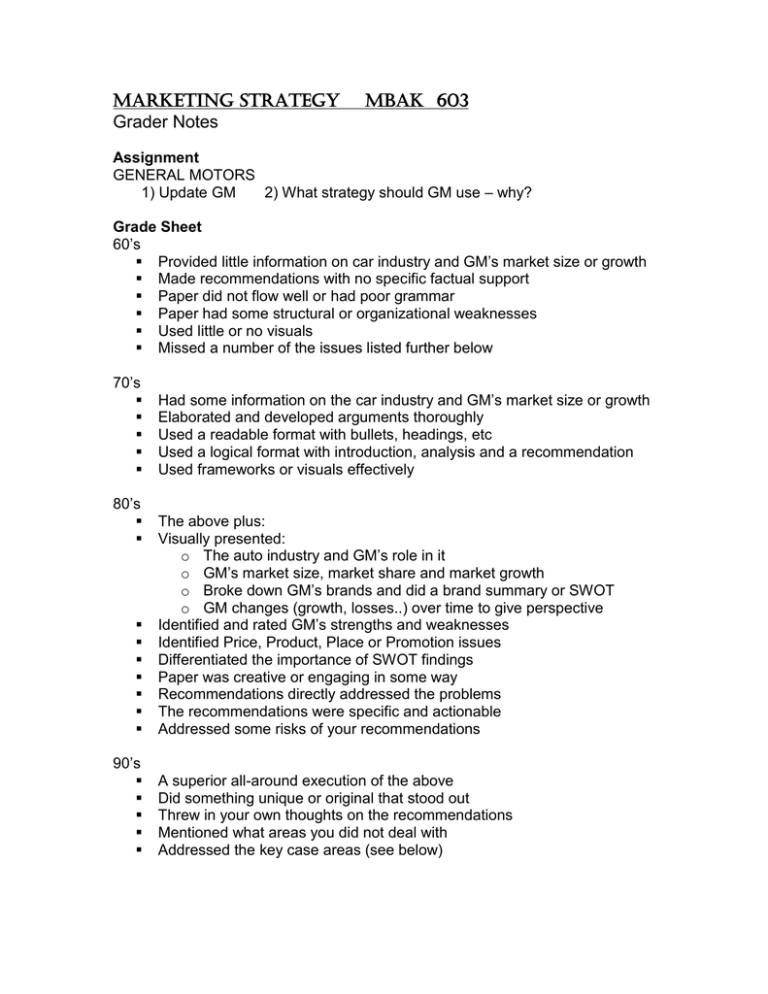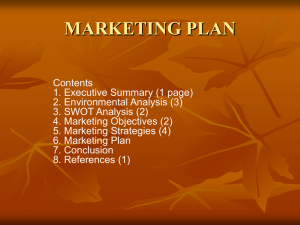MARKETING STRATEGY MBAK 603 Grader Notes
advertisement

MARKETING STRATEGY Grader Notes MBAK 603 Assignment GENERAL MOTORS 1) Update GM 2) What strategy should GM use – why? Grade Sheet 60’s Provided little information on car industry and GM’s market size or growth Made recommendations with no specific factual support Paper did not flow well or had poor grammar Paper had some structural or organizational weaknesses Used little or no visuals Missed a number of the issues listed further below 70’s 80’s 90’s Had some information on the car industry and GM’s market size or growth Elaborated and developed arguments thoroughly Used a readable format with bullets, headings, etc Used a logical format with introduction, analysis and a recommendation Used frameworks or visuals effectively The above plus: Visually presented: o The auto industry and GM’s role in it o GM’s market size, market share and market growth o Broke down GM’s brands and did a brand summary or SWOT o GM changes (growth, losses..) over time to give perspective Identified and rated GM’s strengths and weaknesses Identified Price, Product, Place or Promotion issues Differentiated the importance of SWOT findings Paper was creative or engaging in some way Recommendations directly addressed the problems The recommendations were specific and actionable Addressed some risks of your recommendations A superior all-around execution of the above Did something unique or original that stood out Threw in your own thoughts on the recommendations Mentioned what areas you did not deal with Addressed the key case areas (see below) Key case Points GENERAL MOTORS GM is the largest car manufacturer. It has been steadily losing market share over the last 40 years. It now has 26% of the U.S. market, and the U.S. accounts for 75% of GM’s revenues. Chevrolet is its strongest brand and accounts for 60% of the sales. GM has $10 bil. cash, which gives it some breathing room. GM has been able to reinvigorate Cadillac, so it has a model for change. GM is seeing success in growing Asian markets and particularly in China. In a few years, the huge retirement benefits obligations will peak. We will go through the SWOT in class. How important were the problems you identified and what were the root causes of the problems? How did you rate them and prioritize them? How important is keeping manufacturing costs down? Quality of cars? Getting rid of multiple similar models? Building more appealing cars? Going green or focusing on better gas mileage? Lowering incentives? Based on your prioritization, solutions should be directly relevant to problems and you identified the risks associated with them – for example, problem of too many ineffective brands would mean killing one or more, which would cost somewhere around $2 billion, and would likely anger workers, the union, suppliers, dealers and loyal customers. Recommendations – and why not also for the SWOT factors? Clearly identified and rated the importance of problems: The most important problem is to change the hierarchy and culture of entitlement at GM that prevents change, innovation and teamwork. Connected recommendations directly to problems: Retraining, new hiring criteria and motivating existing workers by doing X, would begin to change the corporate culture, which is a problem at GM. Provided some clear roadmap for the future action: First, an announcement of the new training would be accompanied by incentive bonuses for workers meeting teamwork, quality and innovation targets. Next, criteria for new hires would be changed to bring in more flexible, team-oriented employees… Recommendations solved the problem: These new initiatives would begin to change the hierarchy and combative nature of the corporate culture…

